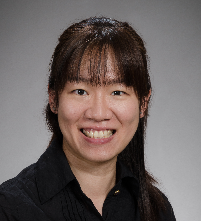MSACL 2022 Abstract
Self-Classified Topic Area(s): Troubleshooting > Tox / TDM / Endocrine
|
|
Poster Presentation
Poster #28a
Attended on Tuesday at 20:00
|
|
 A Stumbling Block of Harmonizing LC-MS/MS Assays in Clinical Laboratories A Stumbling Block of Harmonizing LC-MS/MS Assays in Clinical Laboratories
Hsuan-Chieh (Joyce) Liao, Andrea J. Moore, Geoffrey S. Baird, Andrew N. Hoofnagle
Laboratory Medicine and Pathology, University of Washington, Seattle, WA

|
Hsuan-Chieh (Joyce) Liao, PhD, DABCC, FADLM (Presenter)
University of Washington |
|
Presenter Bio: Dr. Joyce Liao has more than ten years of clinical and management experience in laboratory medicine. She was a medical laboratory scientist in the newborn screening lab and obtained her Ph.D. degree in Clinical Medicine. She completed postdoctoral fellowship training in Clinical Chemistry at the University of Washington and Seattle Children’s Hospital. She is a board-certified Clinical Chemist and now serves as an Associate Director at Harborview Medical Center, focusing on toxicology and mass spectrometry testing. She continues to focus on the translation of the analytical power of mass spectrometry to real clinical applications. Her interests include toxicology, mass spectrometry, and laboratory utilization. |
|
|
|
|
Abstract Problem:
One of the potential benefits of using LC-MS/MS instead of commercially available immunoassays is the ability to generate robust calibration materials de novo in-house and for oversight of the production process and quality assurance to be maintained within the laboratory. Upon calibration with matrix-matched calibrators, the concentrations of tocopherol calculated from the peak area ratio (ratio of unlabeled analyte peak area divided by the isotope-labeled internal standard peak area) in patient samples were different for the same extractions run on two identical LC-MS/MS systems. Using a standard method comparison, the slope of linear regression of the results from one instrument onto the results of the other instrument was at least 10-15% different.
Method Information:
• Serum extracted with sodium hydroxide and n-heptane (liquid-liquid extraction)
• Organic supernatant dried and reconstituted
• Acquity UPLC I-Class with a Column Manager
• Waters TQ-XS Tandem Mass Spectrometer
• Waters Acquity UPLC BEH C18, 2.1 x 50 mm
• Mobile Phase A: 2mM ammonium acetate, 0.1% Formic Acid in LCMS grade water
• Mobile Phase B: 2mM ammonium acetate, 0.1% Formic Acid in LCMS grade Methanol
• 5 mins gradient with 92% to 100% Mobile Phase B
• Quantitative MRM acquisition
Troubleshooting steps:
We assumed that a problem with the mass spectrometer hardware or software settings was most likely. The analytes were individually optimized on each instrument. We verified that gradients, transitions, cone voltages, and collision energies were all identical on the two instruments. The internal standard area was two- to five-fold higher on one of the instruments, which had a different probe type. One instrument was calibrated by the service engineer using a different calibration solution than what the laboratory staff used to calibrate the instrument (Orthophosphoric acid 0.1% Acetonitrile/Water versus Waters TQ-XS set up solution, which includes eight components in a 50% Acetonitrile/Water). Service was called for preventive maintenance.
Outcome
I wrote this up and looking for advice from other experts.
• Both instruments are almost brand new and maintain clinical specifications.
• Set up solution was ordered and the instrument will be re-calibrated using the correct unit mass calibration.
• Both instruments will be switched to the same style probe at the earliest convenience.
• Standards and controls will be run on the two instruments. Different collision energies would be performed to evaluate individual collision cells.
We have the same issues for the other analyte on the other two identical instruments. We think it is a general issue in every clinical lab but somehow it has not been fully addressed.
|
|
Financial Disclosure
| Description | Y/N | Source |
| Grants | no | |
| Salary | no | |
| Board Member | no | |
| Stock | no | |
| Expenses | no | |
| IP Royalty | no | |
| Planning to mention or discuss specific products or technology of the company(ies) listed above: |
no |
|

